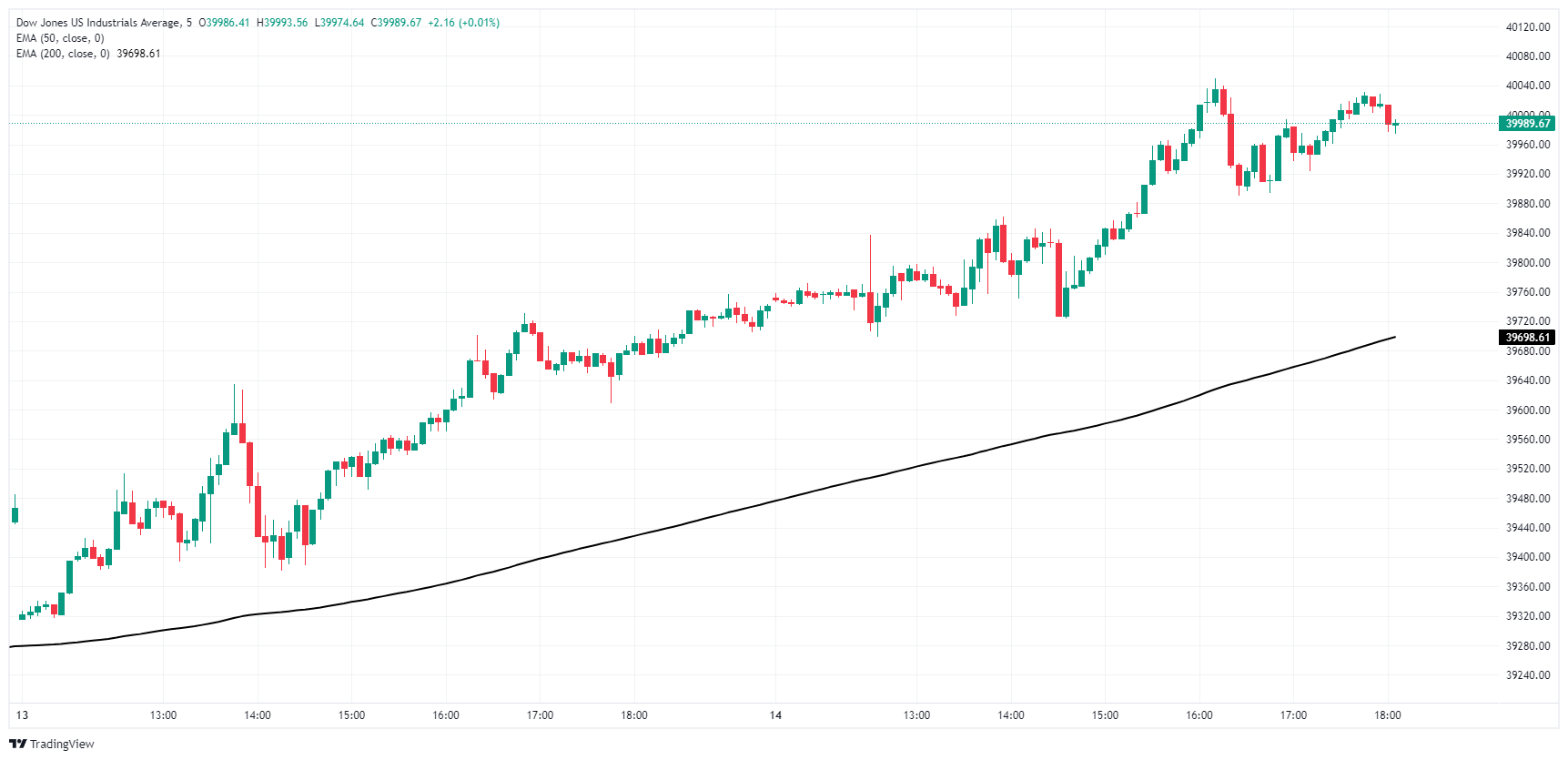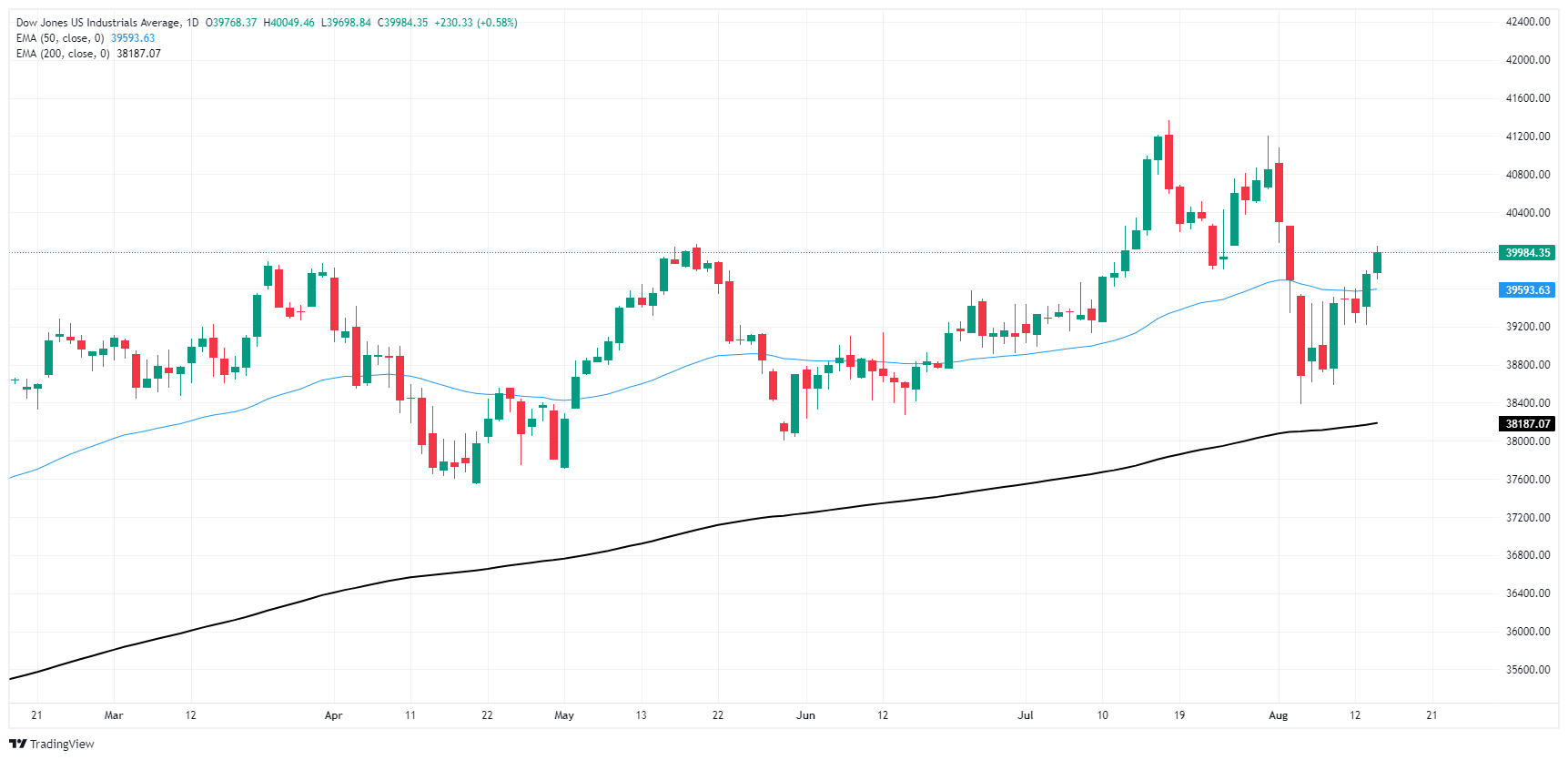- Analytics
- News and Tools
- Market News
- Dow Jones Industrial Average bolstered by US CPI inflation into a second day of gains
Dow Jones Industrial Average bolstered by US CPI inflation into a second day of gains
- The Dow Jones climbed 260 points on Wednesday post-CPI inflation print.
- US consumer-level inflation eased as expected in July.
- Market bets of a September rate cut remain high, but markets were hoping for more.
The Dow Jones Industrial Average (DJIA) gained 260 points on Wednesday after US Consumer Price Index (CPI) inflation ticked lower on an annualized basis, as markets had broadly hoped. However, some investors had higher expectations for this round of US CPI inflation after US producer-level inflation dropped faster than expected earlier this week.
Headline US CPI inflation printed at 2.9% YoY in July, slightly below the forecast hold at 3.0%, with core CPI inflation ticking down to 3.2% on an annualized basis from the previous 3.0% as markets had expected. Monthly CPI figures, both headline and core, rose 0.2% MoM in July, but even this figure was a round-up print from the data rates of 0.15% and 0.17% for headline and core CPI, respectively.
Despite easing consumer-level inflation figures, investors had been hoping for prints further below forecasts after this week’s US Producer Price Index (PPI) inflation showed steeper-than-expected drops in producer-level price pressures. However, easing price pressures don’t appear to be passing onto consumers on a one-to-one basis. According to the CME’s FedWatch Tool, rate markets are now pricing in only 40% odds of a double-cut from the Federal Reserve (Fed) on September 18, down from 50% earlier this week and 70% the week previous.
Dow Jones news
Most of the Dow Jones index is in the green on Wednesday with four-fifths of the equity board climbing post-US CPI. Losses were contained in a core group of recent straggles, with Intel Inc. (INTC) leading the charge lower, falling -2% on the day to $20.00 per share. Home Depot Inc. (HD) claimed the top of the Dow Jones on Wednesday, rising 2.5% and testing $360.00 per share.
Dow Jones price forecast
A second straight day of gains has the Dow Jones index retesting the 40,000.00 major price handle, but bidders will need to put in more work to shove intraday price action north of the key technical level after running out of gas and falling back from 40,040.00.
Wednesday’s gains put the Dow Jones back on the north side of the 50-day Exponential Moving Average (EMA) at 39,593.00. The index is also up 4.3% from a recent bottom near 38,383.00, and buyers have their eyes set on reclaiming all-time highs above 41,200.00 set in July.
Dow Jones five minute chart
Dow Jones daily chart
Dow Jones FAQs
The Dow Jones Industrial Average, one of the oldest stock market indices in the world, is compiled of the 30 most traded stocks in the US. The index is price-weighted rather than weighted by capitalization. It is calculated by summing the prices of the constituent stocks and dividing them by a factor, currently 0.152. The index was founded by Charles Dow, who also founded the Wall Street Journal. In later years it has been criticized for not being broadly representative enough because it only tracks 30 conglomerates, unlike broader indices such as the S&P 500.
Many different factors drive the Dow Jones Industrial Average (DJIA). The aggregate performance of the component companies revealed in quarterly company earnings reports is the main one. US and global macroeconomic data also contributes as it impacts on investor sentiment. The level of interest rates, set by the Federal Reserve (Fed), also influences the DJIA as it affects the cost of credit, on which many corporations are heavily reliant. Therefore, inflation can be a major driver as well as other metrics which impact the Fed decisions.
Dow Theory is a method for identifying the primary trend of the stock market developed by Charles Dow. A key step is to compare the direction of the Dow Jones Industrial Average (DJIA) and the Dow Jones Transportation Average (DJTA) and only follow trends where both are moving in the same direction. Volume is a confirmatory criteria. The theory uses elements of peak and trough analysis. Dow’s theory posits three trend phases: accumulation, when smart money starts buying or selling; public participation, when the wider public joins in; and distribution, when the smart money exits.
There are a number of ways to trade the DJIA. One is to use ETFs which allow investors to trade the DJIA as a single security, rather than having to buy shares in all 30 constituent companies. A leading example is the SPDR Dow Jones Industrial Average ETF (DIA). DJIA futures contracts enable traders to speculate on the future value of the index and Options provide the right, but not the obligation, to buy or sell the index at a predetermined price in the future. Mutual funds enable investors to buy a share of a diversified portfolio of DJIA stocks thus providing exposure to the overall index.
© 2000-2025. All rights reserved.
This site is managed by Teletrade D.J. LLC 2351 LLC 2022 (Euro House, Richmond Hill Road, Kingstown, VC0100, St. Vincent and the Grenadines).
The information on this website is for informational purposes only and does not constitute any investment advice.
The company does not serve or provide services to customers who are residents of the US, Canada, Iran, The Democratic People's Republic of Korea, Yemen and FATF blacklisted countries.
Making transactions on financial markets with marginal financial instruments opens up wide possibilities and allows investors who are willing to take risks to earn high profits, carrying a potentially high risk of losses at the same time. Therefore you should responsibly approach the issue of choosing the appropriate investment strategy, taking the available resources into account, before starting trading.
Use of the information: full or partial use of materials from this website must always be referenced to TeleTrade as the source of information. Use of the materials on the Internet must be accompanied by a hyperlink to teletrade.org. Automatic import of materials and information from this website is prohibited.
Please contact our PR department if you have any questions or need assistance at pr@teletrade.global.















